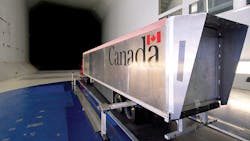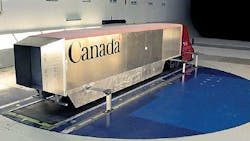And the winner is…trailer skirts.
According to Brian McAuliffe, senior research officer with National Research, trailer skirts are the single most effective addition manufacturers can put on van trailers to reduce aerodynamic drag. Appropriately enough, boat tails were right behind.
The featured speaker on a CTEA Manufacturer’s Conference session on truck and trailer aerodynamics, McAuliffe reported on the work his organization has been commissioned to perform for Transport Canada. The goal of the research is to investigate the aerodynamic improvements possible with current and emerging drag reduction technologies for heavy-duty vehicles. The results are expected to guide future implementation and regulation of such technologies for Canada’s transportation industry.
McAuliffe said the aerodynamic research has focused on four distinct areas:
• Tractor shaping. Manufacturers, McAuliffe said, have done a good job of reducing aerodynamic drag. It’s a selling point for them. Multiple truck manufacturers have taken their vehicles to NCR for testing—and they buy competitors’ models and compare them.
• The gap between the tractor and trailer. “The gap should be closed as much as possible,” McAuliffe said. “I know there are operational issues, but bringing the tractor and trailer as close together as possible is very simple way to save fuel.”
Examples of aerodynamic devices designed to reduce the gap are side extenders mounted at the rear of the tractor and fairings installed on the front of trailers.
• Trailer underbody. “You want to prevent the air from getting beneath the trailer,” he said. “When air gets beneath the trailer, it hits the bogey and generates considerable aerodynamic drag. Side skirts reduce the amount of air flowing beneath the trailer. Other devices guide air around the bogey. Anything that prevents air from hitting the front surface of the bogey is good, but skirts generally are the best option because they keep air out of the area in the first place.”
• Trailer base (or rear). Boat tails are the most common way to reduce aerodynamic drag at the rear. “They are effective because they direct the wake toward the road,” McAuliffe said. “This reduces the size of the wake. The smaller wake, the lower the drag.”
Wind-tunnel testing
The recently conducted research used 30%-scale models. The tractor was adapted from International ProStar sleeper-cab and day-cab configurations. Trailers included 40ft, 53ft, tandem 28ft dry-vans, and a 53-ft platform trailer.
Researchers experimented with configurable underbody and wheels.
The models were placed on a turntable that enabled researchers to examine the effect of various yaw angles and crosswinds. This provides a more accurate representation of real-life operation. McAuliffe said that trucks deal with an average yaw angle of +/-4°.
Each of the devices tested—all of which are currently available—helped reduce drag and save fuel. Gap reduction and trailer fairings both reduced drag by approximately 2-3%. Changing the roof profile cut drag by approximately 4%. Side skirts and boat tails lowered drag by about 10%.
While wind tunnel testing can produce accurate measurements of aerodynamic drag, translating this into real-world reductions in fuel consumption is more challenging.
“Aerodynamic benefits influence fuel consumption only at higher speeds,” McAuliffe said. “The percentage of fuel savings can be misleading. They depend on the duty cycle of the vehicle. To achieve the full benefits of aerodynamic devices, the truck would have to operate at highway speeds 100% of the time.”
Conducting the tests
The National Research Council used a nine-meter wind tunnel to conduct the test. It was equipped with a rolling road, ground effect simulation system (GESS), road turbulence system (RTS), turntable to vary yaw-angle/cross-wind, and boundary-layer suction.
Transport Canada commissioned the research through its ecoTECHNOLOGY for Vehicles program. The program promotes safety, environmental, and performance testing of new and emerging advanced vehicle technologies.
“If your innovations are aligned with these outcomes, the NRC has the expertise to help organizations develop, test, validate, and implement technologies for market,” McAuliffe said.
Details of the NRC research can be found in a paper McAuliffe authored and published in 2015. Titled Improving the Aerodynamic Efficiency of Heavy Duty Vehicles: Wind Tunnel Test Results of Trailer-Based Drag-Reduction Technologies (NRC Report # LTR-AL-2015-0272), the report is available at the National Research Council Canada website www.nrc-cnrc.gc.ca.
For more info on Canadian Transportation Equipment Association - CTEA.
About the Author
Bruce Sauer
Editor
Bruce Sauer has been writing about the truck trailer, truck body and truck equipment industries since joining Trailer/Body Builders as an associate editor in 1974. During his career at Trailer/Body Builders, he has served as the magazine's managing editor and executive editor before being named editor of the magazine in 1999. He holds a Bachelor of Journalism degree from the University of Texas at Austin.
Rick Weber
Associate Editor
Rick Weber has been an associate editor for Trailer/Body Builders since February 2000. A national award-winning sportswriter, he covered the Miami Dolphins for the Fort Myers News-Press following service with publications in California and Australia. He is a graduate of Penn State University.




